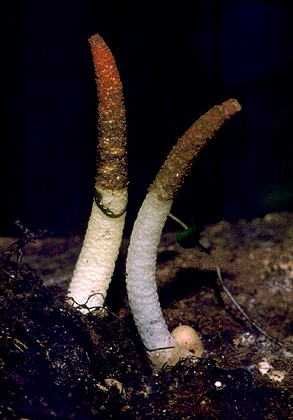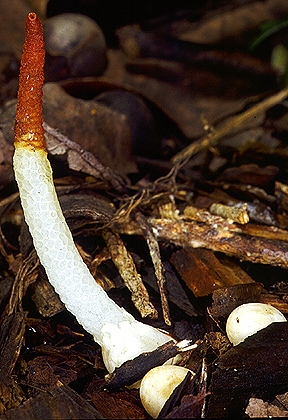
Mutinus borneensis Ces.

Common name: None. A similar species in England is often called Dog's Stinkhorn.
Description: The fungus first appears as white and softly gelatinous eggs about 12 cm in diameter and usually more or less ellipsoid in shape. On expansion, the fungus breaks through the outer skin of the egg to form a simple, pointed, hollow spike about 712 cm tall and up to 20 cm thick at the base. The stem is spongy and soft, white near the base but becoming pink at the top. The spore slime is olive-brown and foetid and it rests directly on the slightly raised pink surface of the upper stem.
The spores measure 35 × 1.52.5 µm and are cylindrical, smooth and colourless. The spore mass is deep olive-brown due to the presence of the background slimy matrix.
Substratum: Found on humus-rich soil or sometimes on very rotten logs where the surface wood has degraded to deep humus. The fungus often occurs in small groups.
Distribution: Known from Queensland, New South Wales and Victoria. Photographic records indicate that a species of Mutinus is present in Tasmania but its identification remains uncertain.
Notes: There are two species of Mutinus in Australia but M. borneensis is the larger of the two. The other, Mutinus curtus, is very small (with a fruiting body up to 3 cm tall and 1.5 cm thick), has been found in New South Wales and Queensland and has a greenish rather than olive-brown spore mass. The species of Mutinus are easily separated from the closely related Phallus which always has the spore mass carried on the surface of a distinct cap at the top of the stem. There is no separate cap in species of Mutinus; the spore slime rests directly on a slightly raised portion at the top of the stem.

